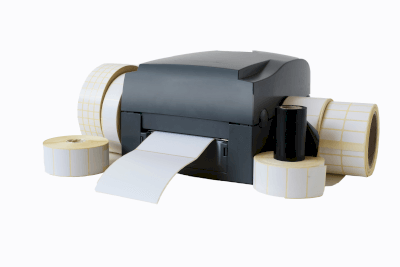What Is a Thermal Printer?

A thermal printer is a printer that prints on thermal paper, plain paper, or labels by applying heat. There are two types of thermal printers, direct thermal printers, and thermal transfer printers, depending on the printing method.
Direct thermal printers print on special thermal paper that is colored by heat. Thermal transfer printers print on plain paper or labels using thermal transfer ink ribbons that melt or sublimate when heated.
Traditionally, thermal printers were only available in black and white, but recent years have seen an increase in the number of thermal printers that can print in color. It can be said that they are competing with inkjet printers.
Uses of Thermal Printers
Thermal print heads are compact, reliable, and inexpensive. Compared to inkjet print heads, thermal printers are widely used for both home and commercial applications because there is no risk of ink clogging the nozzles.
Among thermal printers, direct printers have the advantage of not requiring toner or ink ribbons. Furthermore, the advantages of reliability, low cost, and compactness due to the small number of printer components are significant. They are used in portable label printers that print barcodes and prices and attach them to products.
They are also widely used in cash register receipt printers, mobile printers that can print photos on the spot, and toy printers. Thermal transfer printers, another type of thermal printer, are used in home fax printers because they are inexpensive, compact, and can print on plain paper.
They are also used in label printers for printing barcodes and expiration dates, taking advantage of their low ink bleed, water resistance, and weather resistance. Thermal transfer printers that use dye ink are often used in photo printers, taking advantage of their high expressive power.
Principle of Thermal Printers
Thermal printers print by heating a heating element built into a printing block called a thermal print head. There are two types of thermal printers: direct thermal printers and thermal transfer printers, depending on the printing method.
1. Direct Thermal Printers
Direct thermal printers use thermal paper that chemically reacts to heat to produce color and print directly on the thermal paper using the heat from the thermal print head. This method is characterized by low running costs and compact printer size. On the other hand, thermal paper tends to discolor due to heat or chemicals, making it unsuitable for labels that will be used for a long period of time.
2. Thermal Transfer Printer
Thermal transfer printers use thermal transfer ink ribbons to print by transferring ink from the ink ribbon to paper with the heat of the thermal print head. Thermal transfer printers are used when environmental resistance is required, despite their high cost. However, there is a disadvantage to larger printer sizes.
Other Information on Thermal Printers
Thermal Paper and Ink Ribbons for Thermal Printers
The thermal paper used for direct thermal printers consists of a base paper or film coated with a layer consisting mainly of leuco dye, a dye that can switch between colored and colorless states, and a color developer. The heat from the thermal print head melts the color developer contained in the thermosensitive layer and acts on the leuco dye, causing the leuco dye to emit color. This coloration is controlled by the printer to print characters and barcodes.
There are two types of ink ribbons for thermal transfer printers: the molten thermal transfer method and the sublimation thermal transfer method. The ink ribbon used for the melting type is coated with ink that melts when heated. The heat from the thermal print head melts the ink and transfers it to the paper, where it solidifies and fuses as it cools.
Dye-sublimation type ink ribbons are coated with ink that sublimates when heated, and the heat from the thermal print head vaporizes the ink, which is transferred to the paper. Since the ink density can be continuously controlled by varying the applied heat, smooth gradation can be achieved. It is suitable for photo printers.